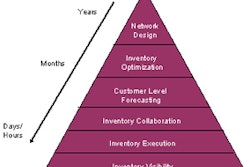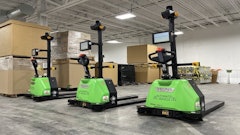In today's fiercely competitive market, the biggest challenge facing retailers is to master the balancing act of keeping the right product mix on hand while keeping inventory levels low. We all know that too much inventory leads to mark-downs, waste or spoilage, let alone high carrying costs, whereas too little inventory may cost retailers lost sales and disappointed customers.
The urgency to address this challenge has risen significantly in recent years, as customer loyalty is getting harder to come by and investors demand higher operational efficiency. The new retail climate has made it imperative to finding that equilibrium point between the shelf availability of optimally allocated/priced products and the right inventory level of such products. The key lies in advanced planning.
The advanced planning we discuss here takes a new-generation approach. It is built on sophisticated solutions and driven by customer demand, and thus is truly helpful to contemporary retailers. Designed to offer an integrated set of planning processes covering all aspects of merchandise financial planning, buying and assortment management, and allocation and replenishment, the new-generation planning solutions will address the aforementioned challenge to ensure that the right products will be carried at the right price in the right stores at the right time.
Furthermore, the new-generation approach is intended to improve operational efficiency and support the retailer's overall strategic objectives. It is reported that companies that have adopted the new-generation advanced planning solutions see sharply reduced inventories, fewer mark-downs and increased sales. A medium-sized retailer with over 200 stores in six countries, for example, was able to reduce markdowns by up to 10 percent and lower inventory by 20 percent.
Stumbling Blocks
Ready to implement advanced planning? Not so fast. Retailers pursuing advanced planning should be cautious about certain stumbling blocks associated with the three key areas of planning: merchandise financial planning, buying and assortment management, and allocation and replenishment. Take merchandise financial planning for example. As AMR Research notes in a 2005 report on Advanced Retail Planning (ARP), financial plans related to merchandise are rarely aligned with those of other departments or with supporting organizational and process areas. As a result, inventory is hardly aligned with strategic business goals. In addition, most companies rely on manual forecasts drawn from educated guesswork rather than detailed analytics on consumer demand. Hence, the accuracy of forecasts suffers. Another flaw of current merchandise planning processes is its inability to support planning at the store level.
Buying and assortment management presents a different set of hurdles. For starters, most retailers base their buying decisions on gut instinct and simple spreadsheet data, instead of the application of sophisticated analytics to create market-specific assortments. Secondly, most retailers are unable to manage assortments in season based on point-of-sale (POS) performance — a capability that would let them respond more quickly to buying patterns. Moreover, the buying process often fails to connect with supply chain execution in a way that enables even inventory flows and, in turn, efficient use of supply chain assets.
The trouble in the area of allocation and replenishment is that few retailers use insights from POS data or the buying and assortment management process to drive efficient allocation and replenishment. For instance, when allocating sizes to stores, few retailers know how to ensure that the right sizes for the desired product arrive in the right stores at the right time. More precisely, if a shoe retailer understands that only a limited number of largest and smallest sizes are likely to be sold in a given assortment, it makes sense to stock these extreme sizes at the start of the season to stretch out the selling period.
In addition to problematic business process and limited visibility to the supply chain, the inflexibility of IT systems used by retailers also poses as a barrier to achieving advanced planning. Most retailers utilize function-specific systems rather than systems that facilitate an end-to-end process. These systems also lack a familiar user interface, so they slow down and complicate the work of planners instead of making it easier.
Success Factors
Daunting as they may be, these hurdles are surmountable if companies adopt a new-generation approach to planning. From our experience in working with a wide range of retailers, we have identified five success factors leading to the mastery of retail balancing act.
1. Combine Art and Science
Most retailers use a rudimentary logic for planning, largely based on historical data and "gut instinct." This may have worked in the past, when the industry was less complex. But in today's global economy, along with the growing number of products and options, retailers typically outsource many aspects of their business, manufacture overseas, coordinate multiple channels — stores, catalogs and the Web — and have to deal with rising expectations from fickle customers. A smart retailer should supplement the art of planning with science that analyzes multiple factors such as sales profiles, store types and locations, and regional and demo-graphic variations. Retailers can gain valuable insights and plan far more effectively by leveraging all available data.
For example, most retailers use simple rules, such as "refill when only five remain," to guide inventory restocking. By using advanced forecasting and replenishment algorithms; however, they can restock each store based on its most current sales trend. Or, instead of using intuition to decide which products to carry in each store, buyers can analyze how similar products have sold in the past to come up with more informed numbers. Analytical tools also let retailers manage inventory based on product and store attributes, so that they can plan how a specific shirt would be sold during the summer in the southern United States, for instance.
2. Be Process-centric
Without a formalized, consistent, disciplined and process-based approach, the retailer is doomed to inefficiency and lost business. Hence, it is essential for retailers to build end-to-end processes rather than focusing on specific functions when they adopt new planning solutions, for a process-centric approach will deliver far more flexibility and allow for continuous innovation. Processes must also be adaptive to changing business needs and market conditions. The best systems can support each retailer's unique processes, instead of force-fitting them into the system's practices and structure.
Ideally, planning processes should integrate the knowledge of each user within the organization to institutionalize best practices. The system should also track process performance and provide feedback on needed improvements. A focus on end-to-end processes also helps to identify disconnects and value leakage that otherwise would be hard to detect and fix.
3. Manage complexity and irregularity
A planning system that is hard to use adds another layer of complexity. Retailers need new-generation planning solutions to manage the underlying data and process complexity so they can focus on what really matters: getting the right products to customers at the right price, in the most efficient manner possible. Complexity also comes from the explosion of data as well as from the processes involved in coordinating across multiple groups within the enterprise and ensuring that everyone is delivering against a common set of goals. Retailers taking the new-generation approach are able to get good, timely information to their buyers and key managers so the latter can make better decisions throughout the buying and assortment management process.
Moreover, with the new-generation approach, retailers are able to automate inventory management by creating business rules (such as "always maintain inventory to cover two weeks of forecast") and then focusing on responding quickly to irregular activities and exceptional events, such as out-of-stock items, excess inventory or major changes in demand. These advanced planning solutions will help retailers generate accurate statistical forecasts for basic items that are carried over from season to season, so that buyers can focus on the more critical fashion or seasonal items.
4. Create dynamic, not static, plans
Companies want a planning process that is dynamic, not static. As more information becomes available and new insights are gained, retailers must have the flexibility to revise and update their plans. It is important to remember that any changes will impact other plans, both downstream and upstream. For instance, a regional product promotion likely will increase sales in that region, which will result in financial and inventory changes throughout the organization. With good tools in place, retailers can update their plans and perform "what-if" analyses, and immediately see the impacts of changes across all affected plans.
5. Achieve supply chain visibility
To build a highly efficient and intelligent supply chain, the retailer needs end-to-end visibility to see the effect of any decision on all aspects of the supply chain, from vendors and distribution centers forward to POS. New-generation planning solutions enable that visibility by tightly integrating with the supply chain, translating plans into execution and operating within any existing constraints. For instance, few retailers ask their vendors to deliver inventory in optimal case packs so it can flow through the supply chain without having to be broken down and repacked for individual stores. Actions such as these make more effective use of supply chain assets and lead to better buying and allocation decisions.
Smart Investment
New-generation planning solutions give retailers the information they need to make more intelligent, better-quality decisions. By automating the basic elements of planning and inventory management, retailers can focus on responding quickly and appropriately to exceptions.
Advanced planning is a journey. Few companies have achieved the total vision; most are tackling it one step at a time. But the benefits we will reap down the road are well worth the investment now. Many companies that have already embarked on the journey report fewer markdowns, fewer lost sales, greater responsiveness to demand trends, greater supply chain efficiency and lower inventory levels throughout the enterprise. But perhaps most important of all, better planning delivers a better shopping experience and, in turn, preserves customer loyalty, which is key to business success in the highly competitive retail environment.
About the Authors: Ajay Chidrawar is a director in i2's Solutions Marketing organization. Adam Hatch is director of marketing for i2's Retail industry group. And Chuck Kramer is the senior vice president and general manager for i2's Retail industry group. www.i2.com.
















![Pros To Know 2026 [color]](https://img.sdcexec.com/mindful/acbm/workspaces/default/uploads/2025/08/prostoknow-2026-color.mduFvhpgMk.png?ar=16%3A9&auto=format%2Ccompress&bg=fff&fill-color=fff&fit=fill&h=135&q=70&w=240)

